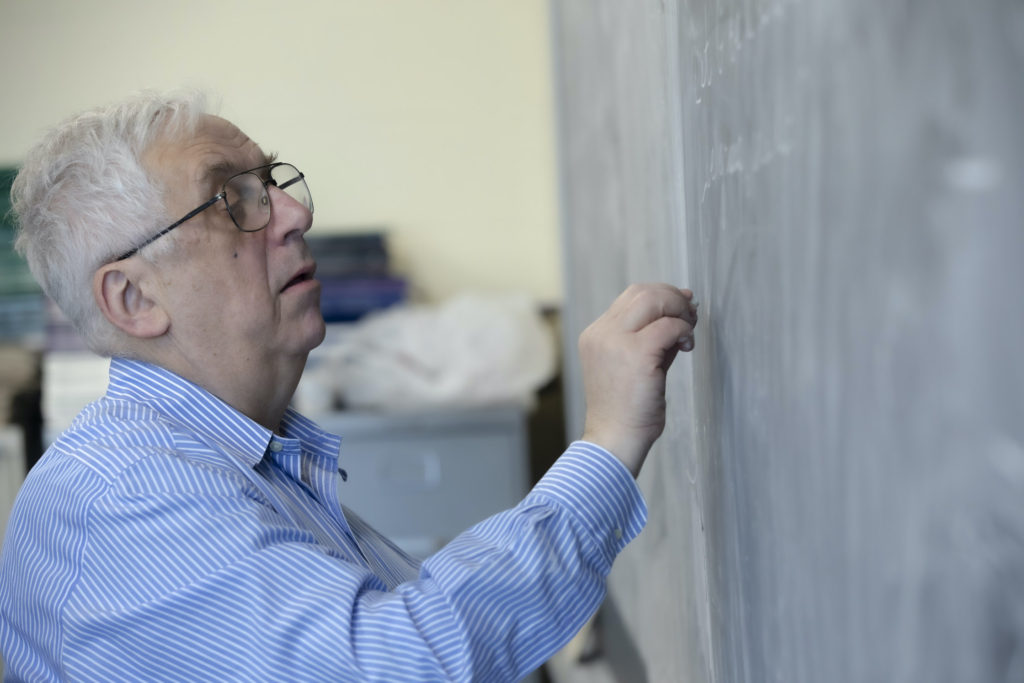
Announcement of the 2020 Abel Prize to Hillel Furstenberg and Gregory Margulis highlighted once again, in the larger domain of mathematics of our times, the important role of ergodic theory and dynamics. Shrikrishna G. Dani has cherished these topics life-long and has also had personal contacts with both the laureates. With Margulis especially, he shared a deeper bond arising out of their collaboration relating to the Oppenheim conjecture. Even though their recurrent contact happened over a limited period, which is well in the past, the memory of it has stayed warm and fresh, which he fondly relives in this article.
In 2006, on the occasion of Margulis turning 60, a conference was held at the Yale University, which I had the good fortune of being able to participate in, and in the course of my talk I made a reference to my being the collaborator of Margulis with the maximum number of joint papers with him. Though I believe I said it with a casual air, I knew it signified a lot, to me as also to others. Later that day Margulis mentioned to me, with no comment of his own, that G.A. Soifer had said to him that my assertion is not true and that he holds the claim. I remember looking into it and confirming, and telling Margulis, with some argument, that my statement did hold. Whatever the precise status regarding comparisons in this respect, my identity as one of Margulis’s principal collaborators has had a long life in public memory, and I often find people looking up to me in that spirit. Unfortunately the story underlying this concerns only a relatively short period, and more importantly relates only to the specific area around the Oppenheim conjecture and what has now come to be called homogeneous dynamics; I find the latter part a major limitation, though of course the area has been an important component of our respective profiles. As such, I find myself quite inadequate for instance to take on the role of a “mathematical biographer” of Margulis, though it would have been a very worthy cause in the context of his immense success, not only in terms of the recognitions he has received, the Abel Prize being the latest feather in his cap, but also his bringing new direction and horizons to the broad area of ergodic theory and dynamics, transforming it radically, which would count for more for a future historian of mathematics. However, here is a feeble attempt to jot down my thoughts on our period together, that would hopefully become in some measure a part of a larger narrative at some stage.
The Oppenheim conjecture
While there are many layers to our mathematical relationship, it is the work on the “Oppenheim conjecture” that somehow stands out as a defining feature. The conjecture goes back to a 1929 paper of Alexander Oppenheim, where it was proposed that if Q is a real nondegenerate indefinite quadratic form in n\geq 5 variables which is not a scalar multiple of a form with rational coefficients (to be briefly referred to as “irrational” in the sequel) then |Q(x)| takes arbitrarily small values, as x runs over the set of all nonzero integer n-tuples; it may be recalled that for such a form with rational coefficients, by Meyer’s theorem there in fact exist nonzero integer n-tuples at which the value is zero, which apparently inspired the preceding statement, as well as the condition n\geq 5 – it was realized later that in the case of irrational forms the same should hold for n\geq 3, and in particular this was stated as conjecture for diagonal forms in a paper of Davenport and Heilbronn in 1946; that the corresponding statement is not true for n=2 is a simple consequence of the existence of what are called badly approximable numbers. In the sequel we shall thus understand the conjecture to be:
Oppenheim conjecture: Let Q be a nondegenerate indefinite irrational quadratic form in n\geq 3 variables and let
\[\begin{align*}
m(Q)=\inf \{|Q(x_1,… , x_n)|\mid x_1, …, x_n\in Z,\ \ \\
\max \{|x_1|,… ,|x_n|\}> 0\}.\end{align*}\]
Then m(Q)=0.
There is seen to have been considerable enthusiasm among number theorists for decades since its formulation, and numerous partial results were proved under various additional conditions involving a lower bound on the number of variables, or the signature of the form, or the structure of the form (e.g. diagonal form); the attention received by the problem is aptly illustrated by the survey article by D.J. Lewis [10], from 1973, covering the results obtained until the early 1970s.
For an enlightening account of the history of the results and methods from a later perspective, but covering also the early works insightfully, I strongly recommend to the reader the paper [13] of Margulis, which has been aptly titled simply as Oppenheim conjecture. In the opening paragraph the author states:
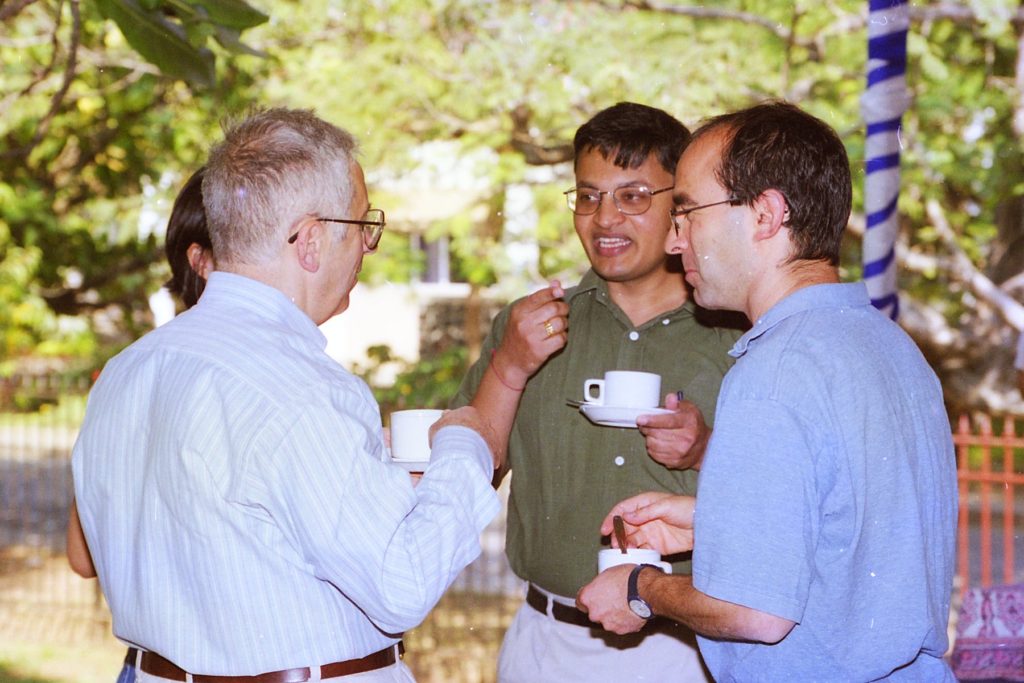 |
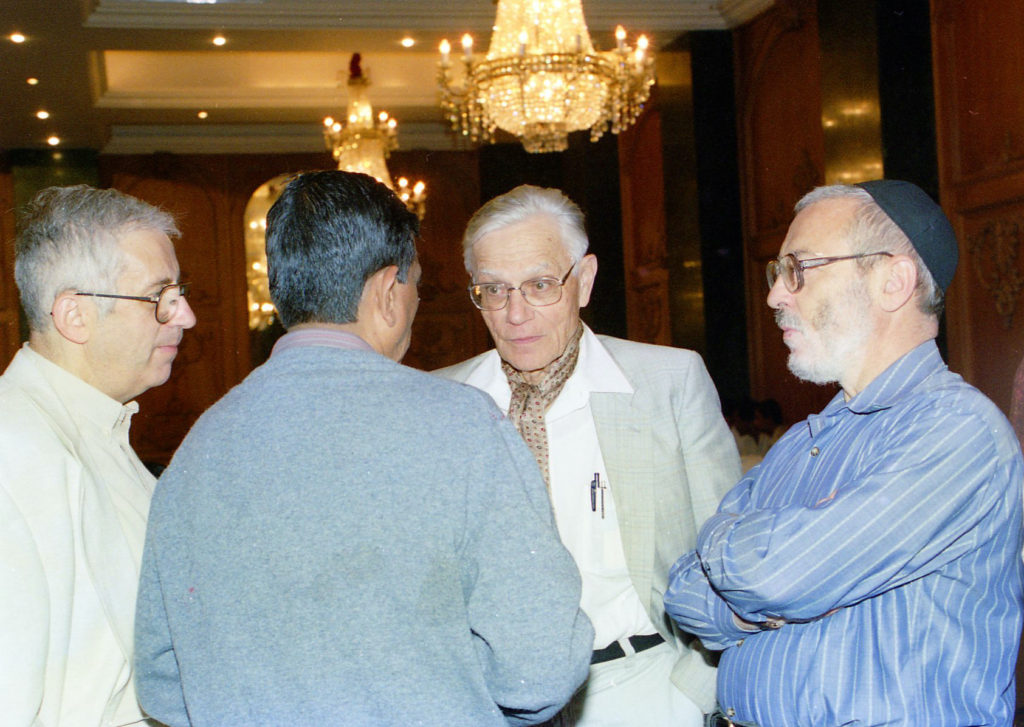 |
and indeed the story unfolds beautifully through the article.
The approach of the proof
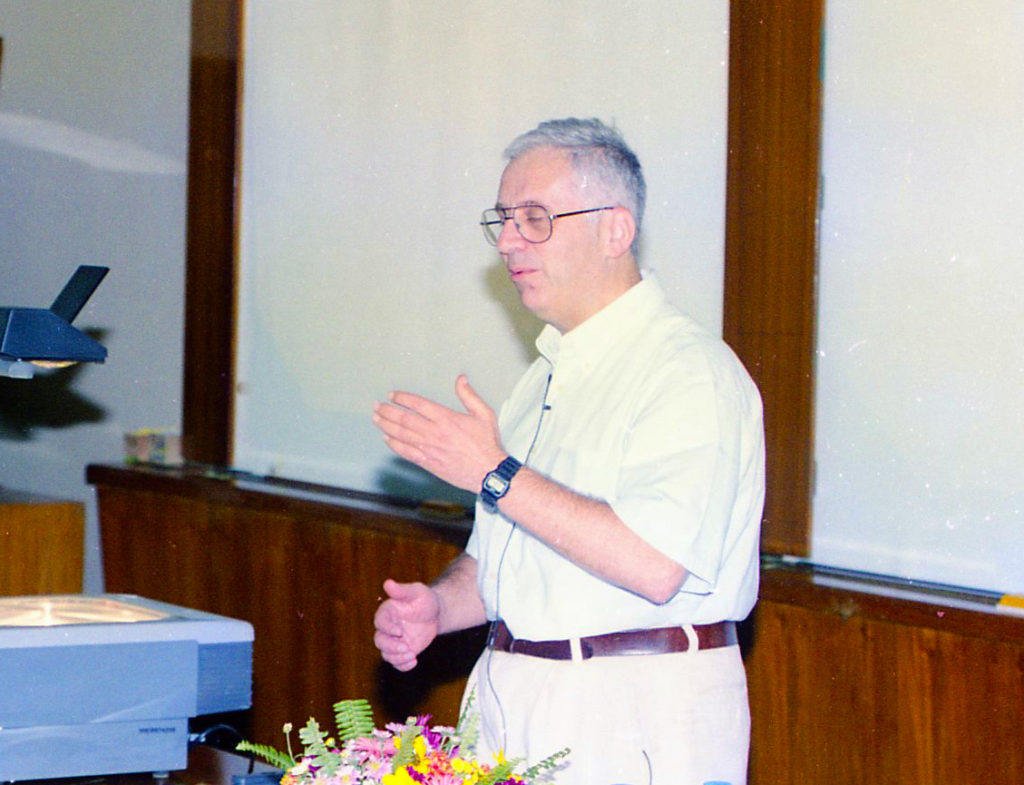
Interestingly M.S. Raghunathan, who was my thesis advisor at the Tata Institute of Fundamental Research, has no paper on the topic. The connection attributed to him as above was first noted in my paper [3], together with a more general conjecture proposed by him (and a related conjecture of my own). A few words regarding the overall context around this may be in order here. I should begin by mentioning that the Oppenheim conjecture was very much a topic of general mathematical chat at the Tata Institute during the early 1970s, with the number theorist colleagues K.G. Ramanathan and S. Raghavan having made contributions related to the conjecture, in the more general framework of algebraic numbers (see [15], [16]). My wife, Jyotsna Dani, did her doctoral work with Raghavan. At the early stages of her work I had a joint paper with her, in the direction which later turned into the topic of the thesis, which was inspired by a suggestion of Raghavan. Referring to her thesis paper Raghunathan states in [17]
Actually he specifically suggested that the closures of orbits of unipotent one-parameter subgroups on G/\Gamma, where G is a Lie group consisting of {\mathbb R} points of a semisimple algebraic group and \Gamma is a lattice in G, ought to be closed orbits of possibly larger subgroups of G, and pointed out how it would give a proof of the Oppenheim conjecture. I vividly remember his words, I may add, conveyed partly in jest, sitting on an office table with legs dangling, “call it my conjecture and prove it”;3 I complied with the first part, in [3], where I found a suitable context in terms of the theme involved.4 If my understanding is correct Margulis became aware of the conjecture and the approach that was being proposed, before a written version of [3] materialized (even as a preprint), through another colleague, Gopal Prasad.
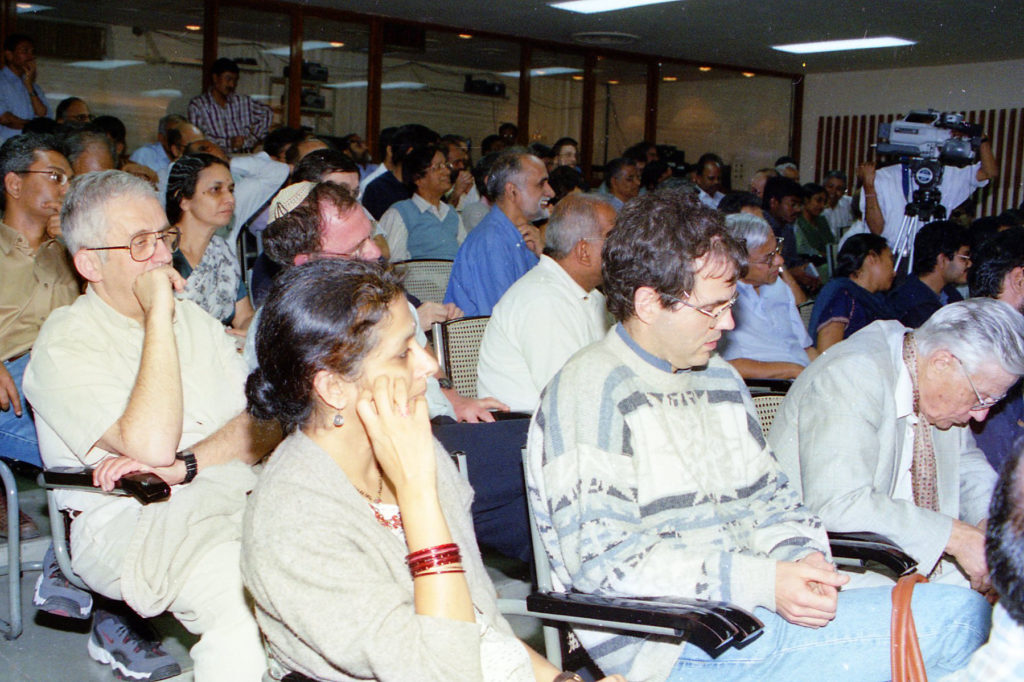 |
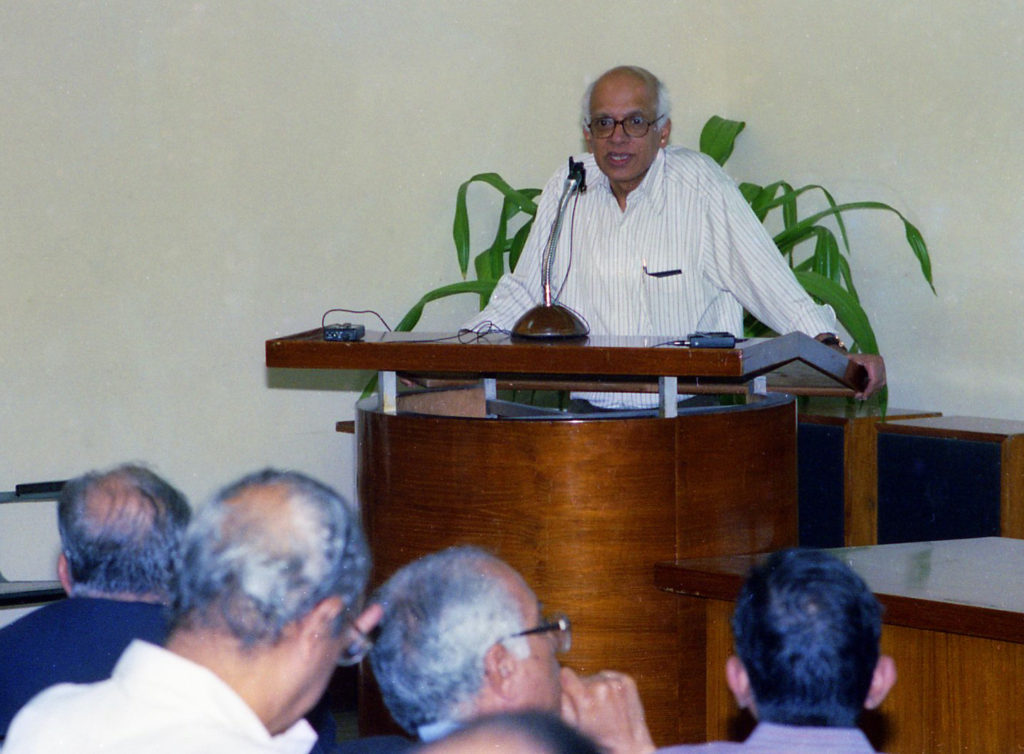 |
| Margulis in the audience at one of the talks at the conference in honour of Raghunathan’s 60th birthday. Jyotsna Dani is seen at his right in the row behind him. At the front right are Sujatha Ramdorai, Yves Benoist and Armand Borel (left). M.S. Raghunathan, author of the Raghunathan conjecture (right). TIFR Archives | |
The news about the proof
The conjecture is known to have been proved by Margulis in 1984; the news spread rather slowly in those pre-email days, largely by word of mouth, and a few letters by post – I remember listening to a purported sketch of the proof, perhaps third or fourth hand in a chain involving David Kazhdan near the other end, in 1985 I think; what was described was hardly clear to me, and did little more than instilling a belief that a proof was indeed in place; curiously, and disappointingly, no details are found in [13] (which would have been a natural place to look for them) of any intermediate stages, and only published papers are mentioned and referred to, beginning with the Comptes Rendus announcement that appeared in 1987. I remember receiving a preprint in August 1987, with a clear and detailed proof, which later appeared in published form in 1989. A somewhat stronger form of the conjecture as mentioned above was proposed by Oppenheim in a 1952-paper, according to which for Q as in the earlier statement, for every \epsilon >0 there exists an integral n-tuple x such that 0< |Q(x))|<\epsilon (the first inequality is additional). Armand Borel mentions in [1] “When informed (by the author, October 1987) of the fact that the Oppenheim conjecture was a slightly stronger one, he [Margulis] quickly completed his argument …”; the latter appeared in [11].
Visiting the Max Planck Institute
It is common knowledge that as a Jewish mathematician in the former Soviet Union Margulis faced discrimination in various ways and in particular could not be present at ICM-1978 at Helsinki to receive the Fields Medal that he was awarded that year; for an illuminating account around this, the reader is referred to [14] – I may mention here that I found Margulis surprisingly devoid of bitterness or rancour on the count, seemingly attributing it to general inefficiency of the administrative systems in the USSR of the time – but, of course, my contact with him was well over a decade after the events in question.
By the late eighties the situation had changed substantially for better and Margulis was able to visit many institutions in the west. In particular, in 1988 he was visiting the Max Planck Institute, Bonn, and he arranged with the help of Günter Harder, for me to visit there for a month. That period happens to be one of the most memorable ones of my life. At the Tata Institute and various other institutions of learning that I had the opportunity to visit by then, I had of course come face to face, and there were also mathematical interactions and socializing, with many illustrious mathematicians, but I was nevertheless quite overwhelmed by the weight of the situation that I was closeted with a Fields Medalist of yore who had now also solved a problem that I had prized, specifically for the purpose of research collaboration. Margulis however put me completely at ease from the very first moment. I had at that time some results on minimal sets and it turned out that using them we could strengthen the theorem proved by Margulis and its application to the Oppenheim conjecture.5 At some point when it became clear that we had landed on something worthwhile, Margulis declared that we should write it up for publication. Having been aware of some Russian works in which the author-names were not in the alphabetical order, I remember asking Margulis in what order our names are to appear as authors, and being relieved by his reply, conveyed in all simplicity!
The month was hectic and I do not recall doing any sightseeing in Bonn during that visit (I may hasten to add that it was not my first visit there, so it did not bother me much). Various details had to be worked out. It was impressive to see Margulis addressing issues that arose along the way. It was not always easy to understand the solutions he offered at various stages. This was usually on account of the intricacies of his thought process, but sometimes also on account of linguistic issues. I remember once on our way to lunch, I was mentioning to him a difficulty with a step in our plan and he kept insisting there is no difficulty – it is a case of “what is it called”, he said, trying to indicate what he meant by gestures, and then by way of a clue added “what you have for a map”. I temporarily gave up, as we were approaching the lunch-place,6 saying I will think it over. Only hours later I realised that the word he meant was “scale” and he meant to say that it is essentially a matter of rescaling, and indeed it was, when viewed in a certain way.
The task of writing out the result was upon me. This was still before the days when computers began to serve mathematicians as tools for keying in and editing their papers. Though apparently word-processors of some kind did exist I had never had the opportunity to set my eyes on one. The route to the birth of a preprint went through a handwritten manuscript, to be passed on to a secretary for typewriting it. The manuscripts themselves needed to be rewritten several times, since while the scope for editing a version, and perhaps more honestly the need for it on account of finding things unsatisfactory or erroneous is often unbounded, the amount of editing a handwritten version can take in while still remaining comprehensible (and acceptable) to one’s typist, is quite limited. The step of producing a satisfactory version was completed after returning to the Tata Institute; the paper reached the editors of Inventiones Mathematicae on 17 November 1988, and was published in 1989. In the meantime an announcement of the result with a short sketch of proof was also published in Comptes Rendus. Our result in the paper marked a certain convincing step between the Oppenheim conjecture and the Raghunathan conjecture, or more accurately its generalized version which was later formulated by Margulis for actions of a larger class of subgroups than the unipotent one-parameter subgroups for which I had originally recorded it.
Indo–Soviet exchange program
Around this time, there were also positive developments with regard to scientific exchanges with the USSR on the eastern front, and especially between India and the USSR, which was to play a beneficial role towards continuation of our collaboration. An Indo–Soviet exchange program had been set up, between the Department of Science and Technology of the Government of India on the Indian side and the USSR Academy of Science on the other side. And the person in-charge of the programme for mathematics from India was none other than my former teacher and colleague at TIFR, and the very spirit behind the conjecture I was after, M.S. Raghunathan. Thus it was a simple matter to wrangle for me to visit the USSR for a month, and subsequently also a visit by Margulis to the Tata Institute.
It was thus that I landed in Moscow in the winter of 1988–89 to be with Margulis for the second time. I was put up in the residency of the USSR Academy of Science which also housed at the time many Indians working in other areas of Science. While this brought some comfort in the cold and depressing weather, it also exposed me to some collective grumbling that the Academy was exploiting the exchange-programme to put to use its facility which was otherwise unusable in the winter. Many of them felt short-changed to have had to undertake the visit during the period.7 As for myself, I would not have wanted to wait for good weather, given what was on my mind.
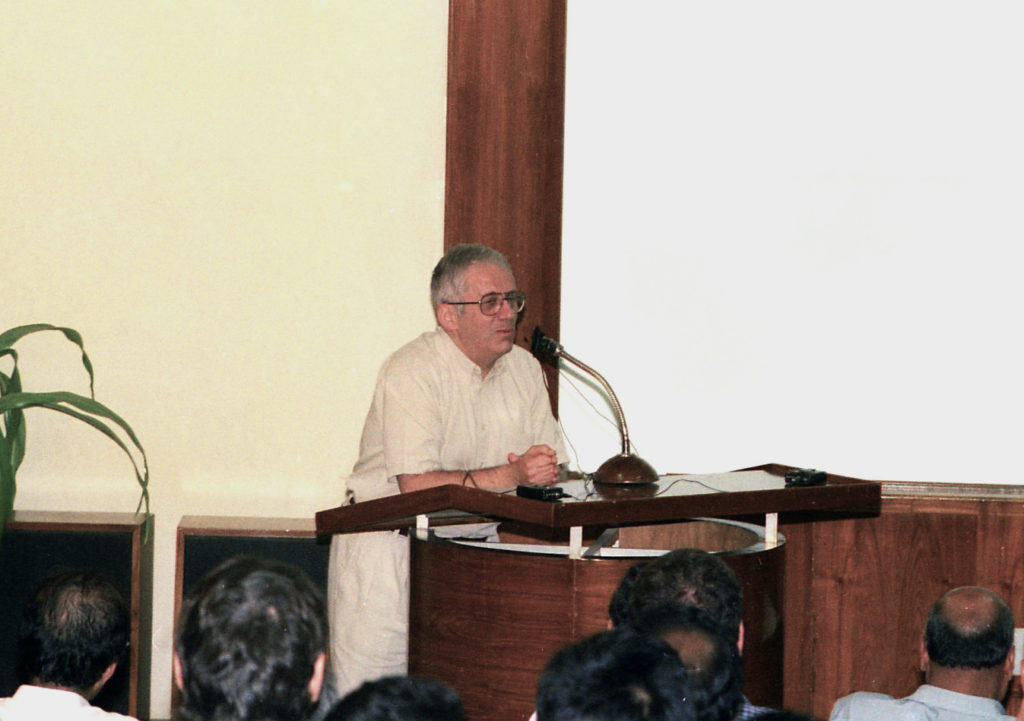
During the Moscow visit I had the privilege of visiting Margulis’s home, and enjoying a lovely dinner and warm hospitality extended by him and his wife. On the day of my departure Margulis came to the residency to see me off. When everything was packed and I was all set to start to leave for the airport, Margulis mentioned to me a Russian custom that when you are ready and setting out on a journey you should sit and rest peacefully for a few moments; this I found rather interesting, and I often find myself putting it into practice since then.
An undemanding guest
Margulis’s visit to India in March 1989, mentioned above, was for me mathematically just a continuation of our previous meeting, but at a personal level it greatly highlighted how simple and undemanding a guest he was, in terms of services at the accommodation and food habits. One day when I met him at the guest house I realised that he had somehow missed breakfast. I lived close by so I took him home. My idea was that my wife would fix something for him (regrettably, I have been a typical Indian male), but on reaching home I found that she had been out. After an uncomfortable wait (there were no mobile phones then to ascertain the status) I decided to find something in the fridge and warm it up for him. I found some sabudana khichadi which I thought would be a good choice, as it had some similarity with a snack I had in Russia. I warmed it up in our microwave and put it in a plate for serving to him. Even as I was readying the dish I had a feeling that something was not quite right, but not finding an alternative I served it for him, and a small portion for myself to keep him company. On returning home my wife informed me that that stuff was never supposed to be warmed in a microwave, as it becomes chewy, and should have been warmed on a pan, over a bit of butter – one lives and learns; fortunately none of such home stuff is known to turn toxic by such misadventures. Margulis however finished the plateful clean, showing no sign of disapproval, and our discussions on the problem at hand proceeded unmindful of the parallel event!
ICM at Kyoto
In 1990 Margulis was invited to give a plenary talk at the ICM at Kyoto. This evidently gave him an occasion to reflect comprehensively on the developments in the topic and put the newfound knowledge and ideas in perspective. The formulations and conjectures that he put out in the talk and the associated article have played a major role in orienting subsequent researches on the topic. The Littlewood conjecture which is one of the problems which he highlighted, together with an approach based on dynamics on homogeneous spaces, akin to that for the Oppenheim conjecture, has been a theme involved in much subsequent work, and has brought more Fields medals to the area, even as in its complete form it remains unsolved as yet.
The Göttingen connection
I had the opportunity to spend the academic year 1990–91 and also the following summer of 1991, at Göttingen, at the invitation of Manfred Denker, under Sonderforschungsbereich-170, a special programme in Germany at that time aimed at promoting advanced research. Actually much of the year went by with my focusing on my other mathematical love, the theory of probability measures on groups. However, for the summer I was able to have a visit of Margulis to Göttingen arranged under the programme, and this made a big difference.
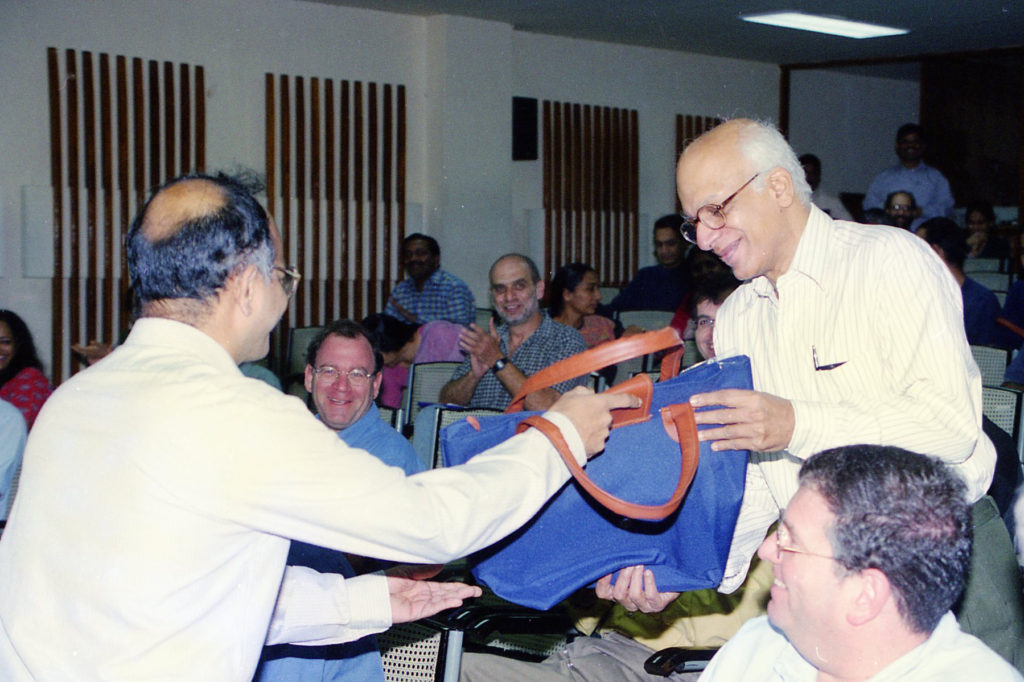
At Göttingen we set out to analyse the issue, now using Ratner’s classification of invariant measures, and applying it to study quantitative aspects of the Oppenheim conjecture; let me content myself mentioning, without going into technical detail, that we were able to conclude in particular that for a quadratic form Q as in Oppenheim conjecture the number of integer n-tuple solutions x, of inequalities of the form a<Q(x)<b, where a,b are real numbers, contained in a ball of radius r centered at the origin, grows asymptotically at least as fast as cr^{n-2} for a constant c which can be explicitly described in terms of the given data. It was a very enriching experience for me to work on this paper with Margulis, with a variety of issues involved along the way. After the visit to Göttingen Margulis moved on to Yale University where he was to settle. I was to continue at Göttingen a little longer, and during this time I had my first trans-atlantic (or across any seas for that matter) phone calls for a mathematical discussion, to sort out some issues that came up after his departure! It took a rather long time for the ideas to crystallize, as I went along my scheduled visits for the following year to MSRI, Berkeley and the University of Chicago, and a short two-week stint in between at Yale University arranged by Margulis. As I.M. Gelfand was to turn 80 the following year and Margulis had an invitation to contribute to a special issue of the Advances in Soviet Mathematics, being brought out in his honour on the occasion, we decided to submit it there, and it appeared as [8]. It has been a paper of ours, that has been cited with quite some regularity so far, for over a quarter century.
Further developments
Our result in [8] was nicely complemented in a work of Margulis with Eskin and Mozes (see [9]) showing that the asymptotic lower bounds correspond to the exact asymptotics involved when the signature of the quadratic form is different from (2,1) or (2,2), and does not hold in general for these cases, there being interesting counter-examples of crucial significance. The asymptotics in particular hold uniformly when n\geq 5, which fits well with Meyer’s theorem for rational quadratic forms. The proof involves many new ideas from different areas. The result stands out as another major landmark in the developments along the Oppenheim conjecture.
Much progress has been made in the area both in terms of broadening the scope and strengthening the results about values of the quadratic forms, the issue of effective versions, as well as the parallel problem of the Littlewood conjecture. Various ideas involved in the study have been applied fruitfully, after suitable generalizations, to problems in Diophantine approximation on manifolds, inspired by the Sprindzuk conjecture, in which also Margulis has played a major role. It would however make a much longer story beyond the scope of this narrative. While Ratner’s work on invariant measures has provided a good deal of fuel for the activity, insights of Margulis have given it the drive and multiple directions to encompass a wide arena, transforming it beyond recognition.
I have also had the pleasure to contribute a bit of my own, and drawing some comfort that some of it has been of relevance to some of the later work of Margulis and his other collaborators, but I deeply miss the old days of collaboration with Margulis. Indeed our paths did merge now and then later as well, for shorter durations, sometimes with my getting benefit of being his former collaborator, and we did share mathematical discussions, but it could not be the same as before. Margulis was elected Honorary Fellow of the Tata Institute of Fundamental Research in 1996 and we were looking forward to seeing him more often in Mumbai. Unfortunately this was not to happen on any significant scale. He visited in 1997 and again in 2001, when we had a conference to celebrate Raghunathan’s 60th birthday, for which he also served as a member of the organizing committee.
Concluding remarks
Let me conclude these reflections with a couple of general comments. To be sure the contents and germinal ideas involved in Margulis’s first proof of the Oppenheim conjecture have quite a different flavour from what was to evolve into the current form of the theory of homogeneous dynamics with its role as a major tool for addressing problems in Diophantine approximation, with the latter bearing a large imprint of the work of Marina Ratner on the Raghunathan conjecture, and the classification of invariant measures of flows on homogeneous spaces, in general. Neither was it the beginning of applications of homogeneous dynamics in number theory, as the cognoscenti would know, as the theme may be traced back at least to L. Auslander and other authors in the sixties, and I had also indulged in such an exercise and made some contributions in the seventies and early eighties. However, Margulis’s proof marks a defining moment in the development of the theory, not just because of the spectacular achievement of settling a long-standing conjecture following the theme, but also its role channelling the energy of those working in homogeneous dynamics in dealing with problems in Diophantine approximation. There is a parallel that may be noted, between the emergence of the area of Geometry of numbers from Minknowski’s work on definite quadratic forms and that of the theory of homogeneous dynamics, which I once chose to call Dynamics of Numbers (see [5]), from Margulis’s proof of the Oppenheim conjecture.
Another important feature of the proof is its great simplicity.10 In the development of mathematics, as in the case of industry, building up heavy machinery and being able to use it on a massive scale to solve problems methodically, and almost algorithmically, is of course of paramount importance. However, innovations not involving the machinery of the time, working with bare hands so to speak, have a great appeal, and also play an important role in enabling one to rethink and build up our understanding to new heights. Margulis’s proof of the Oppenheim conjecture stands out as an example in this respect. While such innovative, almost magical, ideas normally get integrated into the general theory, it is my feeling, which I believe Margulis would share, that in the present instance the full potential of the ideas still remains to be realised.\blacksquare
References
- A. Borel, Values of indefinite quadratic forms at integral points and flows on spaces of lattices, Bull. Amer. Math. Soc. 32 (1995), 184–204.
- J.W.S. Cassels and H..F. Swinnerton-Dyer, On the product of three homogeneous forms and indefinite ternary quadratic forms, Philos. Trans. Roy. Soc. London 248, Ser. A, (1955), 73–96.
- S.G. Dani, Invariant measures and minimal sets of horospherical flows on noncompact homogeneous spaces, Invent. Math. 64 (1981), 357–385.
- S.G. Dani, On the Oppenheim conjecture on values of quadratic forms, Essays on Geometry and Related topics (Memoires Dédiés à André Haefliger), Monographie de L’Enseignement Math., No. 38, Geneva, 2001, pp. 257–270.
- S.G. Dani, Dynamics of numbers, Presidential address at the 80th Annual Conference of the Indian Mathematical Society, Dhanbad 2014, The Math. Student 84 (2015), 7–21.
- S.G. Dani and G.A. Margulis, Values of quadratic forms at primitive integral points, Invent. Math. 98 (1989), 405–424.
- S.G. Dani and G.A. Margulis, Values of quadratic forms at integral points: an elementary approach, L’Enseignement Math. 36 (1990), 143–174.
- S.G. Dani and G.A. Margulis, Limit distributions of orbits of unipotent flows and values of quadratic forms, Advances in Soviet Mathematics 16 (1993), 91–137.
- A. Eskin, G.A. Margulis and S. Mozes, Upper bounds and asymptotics in a quantitative version of the Oppenheim conjecture, Ann. of Math.(2) 147 (1998), No. 1, 93–141.
- D.J. Lewis, The distribution of values of real quadratic forms at integer points, roc. Symos. ure Math., vol XXIV, Amer. Math. Soc., Providence, RI 1973, 159–174.
- G.A. Margulis, Discrete subgroups and ergodic theory, Number Theory, Trace Formulas and Discrete Groups, (Symposium in honour of A. Selberg), Academic Press, San Diego, CA, USA, 1989.
- G.A. Margulis, Dynamical and ergodic properties of subgroup actions on homogeneous spaces with applications to number theory, Proceedings of the International Congress of Mathematicians, Vol. I,II (Kyoto, 1990), Math. Soc. Japan, Tokyo, and Springer, 1991, 193–215.
- G.A. Margulis, Oppenheim conjecture, Fields Medalists lectures, 272–327, World Sci. Ser. 20th Century Math. 5, World Sci. publ. River Edge, NJ, USA, 1997.
- G.D. Mostow, Margulis, J. Modern Dynamics, Vol. 2, No. 1, 1–5.
- S. Raghavan and K.G. Ramanathan, On a Diophantine inequality concerning quadratic forms, Nachr. Akad. Wiss. Göttingen Math.-Phys. K I, II (1968), 251–262.
- S. Raghavan and K.G. Ramanathan, Values of quadratic forms, J. Ind. Math. Soc. 34 (1970), 253–257 (1971).
- M.S. Raghunathan, S.G. Dani as I have known him, Contemporary Mathematics, Vol. 631, 215, 1–3.
Footnotes
- The criterion states that a sequence \{\Lambda_j\} of lattices in {\mathbb R}^n with a given discriminant (the volume of any fundamental parallelopiped) admits nonzero x_j\in \Lambda_j with \{x_j\} converging to 0 as j\to \infty, if and only if \{\Lambda_j\} is a divergent sequence in the space of lattices; the latter space has a natural locally compact second countable topology with respect to which it is noncompact, and a sequence being divergent means it eventually escapes every given compact subset. ↩
- A further analysis comparing the respective approaches would however be of interest from a historical point of view. ↩
- Unfortunately I have no clear memory as to when this occurred, but the best fit seems to be sometime in 1975–76; in September 1976 I left for the US for two years, and it has to be before that. ↩
- The second part unfortunately proved beyond me, but the pursuit was instrumental, I think, in the question being settled eventually by Marina Ratner. ↩
- In the equivalent result in the group theoretic formulation it amounted to proving that every \rm SO(2,1)-orbit in {\rm SL}(3, {\mathbb R})/{\rm SL}(3, {\mathbb Z}) (not necessarily contained in a compact subset) is closed, unless it is dense, and this would imply that for a quadratic form, as in the Oppenheim conjecture, values at primitive integral points are dense in {\mathbb R}. ↩
- Incidentally, going for these lunches, together with other visitors and sometimes with Harder and/or Hirzebruch was an enjoyable experience; the joy would be augmented when sometimes Hirzebruch, then Director of the Institute, decided to foot the bill for everyone in company. ↩
- To be fair I should mention that the Academy took good care of us, and we were also provided “interpreters”, young people, who would take us around for sightseeing and shopping, so we did not depend for these chores on our collaborators, who may have found it hard to spare their time for the purpose. ↩
- I may mention however that I had the opportunity to visit the Moscow State University, where I participated and also gave a talk in Sinai’s Seminar. ↩
- In a somewhat different flavour this featured also in a paper of Alex Eskin, Shahar Mozes and Nimish Shah, but the impact of Margulis’s strategy is more direct. ↩
- The simplicity of the original proof also inspired further simplifications as in [7] and [4]. ↩
